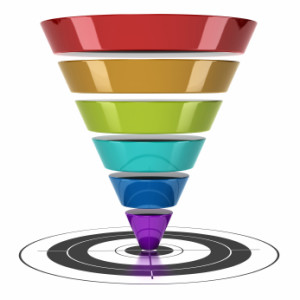by gabriel_sales | Jun 27, 2014
 By now, everyone in B2B knows that quality marketing content can contribute directly to sales. The idea is that by giving your prospects valuable content that assists them in their buying process, you help build the trust required to motivate a purchase.
By now, everyone in B2B knows that quality marketing content can contribute directly to sales. The idea is that by giving your prospects valuable content that assists them in their buying process, you help build the trust required to motivate a purchase.
In attempting to use marketing content for sales objectives, one mistake a lot of companies make is failing to help prospects move smoothly through each stage of their buying process. Many companies simply make a bunch of content, throw it up on their website and expect magic to happen. There’s a little more to it than that.
The content you create, whatever it says, needs to help guide prospects—stage by stage—through your sales cycle. This means you need to different create content for each stage (discovery, education, verification, etc.) that speaks directly to the main interests and concerns prospects have while in each stage.
For example, let’s say you are selling marketing automation software. Some of your early-stage prospects are going to have no idea what marketing automation is. For these prospects, you need to have some light, educational content that answers the basic question, “What is Marketing Automation?” However, other prospects are already going to know a lot about marketing automation and want content that helps them to compare options and verify they’re making the right choice. For these prospects, different content—e.g. a software comparison matrix—is needed to assuage concerns and keep the deal moving forward.
Once you have content created for each stage of your buyer’s journey, you are almost set up for success, but not quite. The final step is connecting the dots for your prospects, so they can take themselves through your sales process on their own. This is relatively easy to do, but requires some thought.
Connecting the dots for your prospects requires getting into their head and figuring out how a prospect is likely to think through your buying process. Using the example above, an early stage marketing automation shopper will first wonder, “What is marketing automation?” then, they might ask, “What advantages will marketing automation give me?”. If the prospect is still interested at this point, they might ask, “Is my company ready for this type of investment?” Once a prospect has decided they want to make a purchase, their questions might change to things like, “What is the implementation process like?” or “What payment options do I have?”
As you can see, each of these questions requires a different piece of marketing content. However, you can make the process of going through all the content smoother by leaving different links or ‘breadcrumbs’ that guide prospects logically through each stage. Using our marketing automation example, at the end of the “What is marketing automation?” content, add a link to a blog on “5 Advantages of Marketing Automation in 2014”. At the end of the ‘advantages’ blog, leave a link to a video on “How to know if your company is ready for marketing automation”. And on and on to the end of your sales cycle.
Many times, prospects only need a little bit of help to get them to take an action to take the deal forward. By making it as easy as possible for prospects to self-educate and take themselves through their own buying process, we make it more likely that prospects will like us and eventually, trust us enough to make a purchase.
Read more about creating content for sales in 5 Steps to B2B Content Engagement Success.
by gabriel_sales | Jun 25, 2014
 This is the second half of a blog series on questions to ask when considering a B2B marketing automation platform. You can find part one here.
This is the second half of a blog series on questions to ask when considering a B2B marketing automation platform. You can find part one here.
4. Do you need to be able to do social media?
While social media will probably always be a more effective marketing tactic for B2C than B2B, it doesn’t mean that B2B companies shouldn’t try to play the social media game. A marketing automation platform can be a great way to boost a B2B company’s social media effectiveness by offering analytical data and allowing for scheduled/automated posts.
However, it is important to know that not all marketing automation platforms are equal when it comes to social media. For example, Act-On, HubSpot and Marketo offer social media profiling, but Oracle Eloqua does not.
5. What are your payment needs/requirements?
Obviously, price is going to be a factor in any companies’ marketing automation selection process. In addition to looking at the overall cost for the value provided, B2B companies should also consider what payment plans are available and what is going to work best from a business perspective.
When it comes to selecting the right tool, there are about as many different pricing structures as there are marketing automation platforms. Some platforms have tiers based on database size; others have different prices for the amount of features or services used. Additionally, some platforms allow you to pay on a month-to-month basis while others require an annual agreement upfront. It’s all about what solution is best for your specific situation and goals.
6. Do you have the internal skills/expertise to gain ROI quickly?
Having a marketing automation platform is one thing, learning how to use it effectively for both sales and marketing is another. A report from earlier this year found that it took 64% of users at least six months to see results from their platform. The users listed lack of expertise to use the data and intelligence offered by the software (55%) and complexity of marketing automation software (34%) as two of their top obstacles.
This data shows that when it comes to marketing automation implementation, there is generally a long learning curve. If you do not have marketing automation expertise internally, you can end up having to devote a ton of resources to get everything up and running smoothly. We obviously have some bias here, but this is one place where hiring marketing automation consultants or an outsourced sales and marketing team can be greatly beneficial. By leveraging external resources, you can streamline your implementation process and quickly get up to speed on best practices as well as what to avoid.
If you’re curious to learn more about B2B marketing automation, you can read 3 Tips for Success from an Outsourced Marketing Automation Provider. Feel free to contact us with any questions or visit our services page to learn more about the marketing automation consulting we offer.
by gabriel_sales | Jun 23, 2014
 According to a 2014 Buyer’s Guide on marketing automation platforms, 26% of B2B companies are planning on integrating a marketing automation platform into their sales and marketing program in the next 12 months.
According to a 2014 Buyer’s Guide on marketing automation platforms, 26% of B2B companies are planning on integrating a marketing automation platform into their sales and marketing program in the next 12 months.
For these companies with no prior marketing automation platform experience, the evaluation process can be daunting. Each platform seems to offer something a bit different in terms of features and capabilities, which can make it hard to know which platform will be most effective for your company.
To help you get started, here are six basic questions to ask when selecting a marketing automation vendor:
- Is your digital marketing program mature enough to warrant a marketing automation platform?
While marketing automation can be a game changer for many companies, not all companies have developed their digital marketing programs to the point that an automation system is necessary.
One of the main benefits of having a marketing automation system is having the ability to efficiently track and manage the many aspects and channels now involved in digital marketing (CRMs, website/landing pages, email marketing, social media, PPC, SEO, etc.). If your B2B marketing program does not currently involve a multi-channel approach supported with content marketing, adding a marketing automation platform is not really going to help you much.
For a marketing automation platform to be most effective, it needs something to track. This means you need a solid database of prospects and quality marketing content to send to them. This way, you can see which prospects are engaging with what content/messages to help better determine how to move them through the sales pipe to close.
2. What are your integration needs?
If you’ve determined that your marketing program would benefit from an automation platform, the next step is determining what your integration needs are.
Generally, the most important integration to consider is your customer relationship management system (CRM). Without this type of integration, you will vastly limit the effectiveness of any marketing automation platform in terms of sales. Some marketing automation platforms can integrate with four or more different CRMs (e.g. Oracle CRM, Net Suite, Microsoft Dynamics, etc.) while others can only integrate with Salesforce. If you are attached to the CRM you are using currently, you should select a marketing automation vendor that will allow for easy integration.
It is also important to consider any other integrations that would be useful in your sales process. For example, the ExactTarget platform Pardot allows for integration with Outlook to allow sales reps to send and track one-off emails. Many other platforms (e.g. Act-On, Etrigue) do not allow for this type of integration, so consider whether or not this capability is critical when selecting the right tool for your business.
3. How big is your database?
Another aspect to consider when selecting a B2B automation tool is volume. There are some platforms out there that have limits on the number of contacts or prospects you can have at any given time (e.g. 3,000, 10,000). If you are a startup or a growing business, you may want to keep in mind that the number of prospects you have now is likely to grow, and you want your marketing automation platform to be able to support that growth. Conversely, if you are fairly confident that you already have most of the ‘universe’ for your given market within your database, you can opt for a platform with a smaller contact/prospect limit.
Additionally, some platforms have limits on the number of emails that can be sent at one time or sent daily. For example, Etrigue allows 1,000 people to be marketed to at one time. If your marketing requirements are greater than that, you will want to select a tool with higher volume limits for email campaigns.
Continue reading.
by gabriel_sales | Jun 19, 2014
 On the internet, you run into a lot of different types of people: bloggers, shopping addicts, trolls, information junkies, conspiracy theorists, hackers; this list goes on and on. However, in terms of commercial activities, there are generally only two types of people you need to pay attention to: searchers and sharers.
On the internet, you run into a lot of different types of people: bloggers, shopping addicts, trolls, information junkies, conspiracy theorists, hackers; this list goes on and on. However, in terms of commercial activities, there are generally only two types of people you need to pay attention to: searchers and sharers.
Searchers and sharers are different breeds. One lives on SERPs and the other on social platforms. They also have different desires, different motivations and different end goals.
Searchers
People who access content via search engines are looking for something specific. They have a specific question in mind and want the answer to that question now. They don’t want to have to scroll through endless text on to find the one detail they want; they would prefer it if their answer is in the first sentence of the webpage.
In terms of marketing content, this means that searchers want information to easily locatable and extremely clear in terms of meaning. Titles can play a big role here as having the right keywords in your title is still a big factor in terms of where you rank on SERPs. Additionally, when designing content for searchers, ask yourself, “Does this content thoroughly and accurately answer a question my target demographic might have?” If so, you’re on the right track.
Sharers
Those who access your content via social media are generally in a very different headspace than people who are searching. People who search are usually thinking, “I need to find this answer. Now.” Conversely, people who are on social media might be thinking, “Please distract me from how bored I am at work,” or “I need a break. Let me check my Facebook.” People on social media, or ‘sharers’, usually do not have a pressing need when accessing marketing content and are looking to be distracted or entertained in some way.
The content that will best engage sharers is therefore going to be slightly different than the content that engages searchers. You can take a little bit more creative liberty with your titles for sharers, as the best optimized titles for SEO aren’t necessarily the most human-friendly and attention-grabbing. Finally, sharers also want content that educates or provides enough entertainment value to warrant actual ‘sharing’—so here is the chance to let either your intellect or personality shine.
For more tips on creating B2B content for SERPs and social, read 3 Tips to Improve B2B SEO in 2014. Feel free to contact us with any questions.
by gabriel_sales | Jun 19, 2014
B2b content engagement (continued) 
This is the second part of a 2 part blog on B2B content engagement. You can find part 1 here.
3. Make your prospect the hero
If the story you are telling in your marketing content features you as the main protagonist, you’re doing yourself a disservice. Building on the point above, stories enable people to imagine themselves in other scenarios and internalize new ideas or beliefs as their own.
By creating a story that allows your prospect to imagine himself as a hero (e.g. saving the day and earning the boss’s praise for finding the perfect solution for X), you create a major incentive to transact, so he can become that hero he imagined.
- Set up an emotional experience
We’ve written previously on why emotional connection matters more in B2B than in does in B2C. One aspect is that with higher risk sales, people need emotional assurance that things will go well in order to ease their anxieties.
Additionally, “behavioral psychologists have long argued that only 30% of human decisions are actually driven by rational considerations. This means more than 70% of customer loyalty and spending decisions are based on emotional factors.” Because we are so emotionally motivated, anything you can do to create an emotional experience for your readers will keep them more engaged. There are many ways you can facilitate an emotional response in your marketing content—humor, building action to create excitement, ending with a ‘hook’ to keep people coming back for more, etc.
5. Get it out there. Fast.
One of the biggest mistakes B2b companies make in their initial content marketing efforts is thinking that all you have to do to get prospects to engage with you is post content on their website. In terms on engagement, publishing content—like a blog—should merely be the first step in getting the content to your target audience.
Additionally, founder of Moz Rand Fishkin recently wrote that in terms of SEO, “One of the harsh truths of blog-focused SEO is that a few hours after a post is published, 90% of the ranking ability is spent. . . It’s that first burst of activity – of social sharing and people emailing it around and links coming in – that set the stage for ranking success in the search engines.” This means that the quicker you can get your content out and shared on a variety of platforms, the wider the reach your content will have and consequently, the more engagement.
For more tips on creating engaging marketing content, you can read 5 Ways Your B2B Content Marketing Program Can Fail. Feel free to contact us with any questions.
 By now, everyone in B2B knows that quality marketing content can contribute directly to sales. The idea is that by giving your prospects valuable content that assists them in their buying process, you help build the trust required to motivate a purchase.
By now, everyone in B2B knows that quality marketing content can contribute directly to sales. The idea is that by giving your prospects valuable content that assists them in their buying process, you help build the trust required to motivate a purchase.




